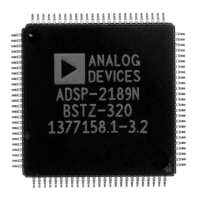1 Introduction
1 – 2
• Memory—The ADSP-2100 family uses a modified Harvard architecture
in which data memory stores data, and program memory stores both
instructions and data. All ADSP-2100 family processors contain on-
chip RAM that comprises a portion of the program memory space and
data memory space. The speed of the on-chip memory allows the
processor to fetch two operands (one from data memory and one from
program memory) and an instruction (from program memory) in a
single cycle.
• Serial Ports—The serial ports (SPORTs) provide a complete serial
interface with hardware companding for data compression and
expansion. Both µ-law and A-law companding are supported. The
SPORTs interface easily and directly to a wide variety of popular serial
devices. Each SPORT can generate a programmable internal clock or
accept an external clock. SPORT0 includes a multichannel option.
• Timer—A programmable timer/counter with 8-bit prescaler provides
periodic interrupt generation.
• Host Interface Port—The Host Interface Port (HIP) allows direct
connection (with no glue logic) to a host processor. The HIP is made up
of 16 data pins and 11 control pins. The HIP is extremely flexible and
has provisions to allow simple interface to a variety of host processors.
For example, the Motorola 68000, the Intel 8051, or another ADSP-2100
family processor can be easily connected to the HIP.
Table 1.1 ADSP-2100 Family Processor Features & On-Chip Peripherals
Feature 2101 2103 2105 2115 2111 2171 2173 2181 2183 21msp58
Arithmetic/Logic Unit ••••••••••
Multiply/Accumulator ••••••••••
Shifter ••••••••••
Data Address Generators ••••••••••
Program Sequencer ••••••••••
Data Memory RAM 1K 1K 512 512 1K 2K 2K 16K 16K 2K
Program Memory RAM 2K 2K 1K 1K 2K 2K 2K 16K 16K 2K
Timer ••••••••••
Serial Port 0 (Multichannel) •• – •••••••
Serial Port 1 ••••••••••
Host Interface Port ––––•••––•
DMA Ports –––––––••–
Analog Interface –––––––––•
Supply Voltage 5V 3.3V 5V 5V 5V 5V 3.3V 5V 3.3V 5V
Instruction Rate (MIPS) 20 10 13.8 20 20 33 20 33 33 26

